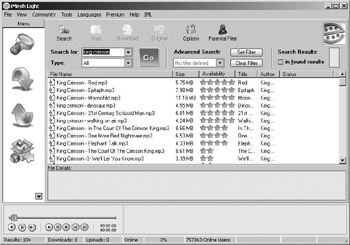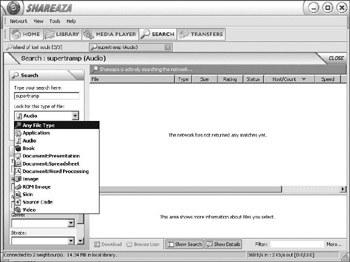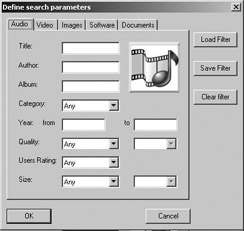HOW FILE SHARING WORKS
|
| < Day Day Up > |
|
The whole idea behind file sharing is to connect everyone in a network so that every computer can copy files from any other computer over the Internet. The types of files you share can be anything from programs and pictures to music and movies. If you can store it in a file, you can share it over a file sharing network.
To connect to one of the many file sharing networks available, you need a file sharing program. In technical terms, a file sharing program turns your computer into both a client and a server. As a client, your computer can search a file sharing network to find and copy files from any other computer on the network. As a server, your computer can provide files to anyone else on the network. Once you’ve installed a file sharing program on your computer, you’re ready to start searching for files.
| Note | Note Visit See What You Share on P2P (http://www.seewhatyoushare.com) for a look at what people share online: everything from ordinary pictures to police reports to military records listing individual soldier’s home and cell phone numbers. |
SEARCHING FOR A FILE
Searching for a file is like using a search engine on the Internet. At the simplest level, just type in a word or phrase that describes what you want to find, such as a song title or a musician’s name, and the file sharing network returns a list of matching files, as shown in Figure 2-1.

Figure 2-1: Searching for a file can be as simple as typing in a song or artist name.
Unfortunately, if you type in a song title or artist name, you’re likely to get a long list of irrelevant files. For example, searching for the music group Heart will also turn up songs from recording artists like Black Heart and Brave Heart; songs with names like “Broken Heart” and “Atom Heart Mother”; and even videos like “Wild at Heart.” To avoid this problem, file sharing programs let you limit your search to specific types of files, such as audio or video, as shown in Figure 2-2.

Figure 2-2: Many file sharing programs let you specify the type of file you want to search for, such as a program or an audio file.
Once you’ve identified the specific file types you want (audio, video, programs, and so on), you can enter more specific information, such as the name of the recording artist and a specific album, as shown in Figure 2-3.

Figure 2-3: You can narrow your search criteria to specific details, such as the names of recording artists and albums.
Once your file sharing program displays a list of files that match your search criteria, you choose the files you want, and your computer starts transferring them across the network from some stranger’s computer to yours.
That’s the theory, anyway. The reality is that you may get cut off in the middle-of a file transfer, especially if the person whose computer contains the file you want suddenly turns their computer off. Other times, you may get the file you want, only to find out that the file has been misnamed, so instead of seeing the latest Star Wars trailer, you’ve really downloaded a pornographic movie instead. Even worse, sometimes the file you get is exactly what you want, but the sound or video quality is so poor that it’s practically useless. When downloading files, be prepared for a lot of frustration—but if you use a computer on a regular basis, you should already be used to that.
LINKING TO A FILE
Besides poor-quality files, misnamed files, and files that contain only part of what you really want, you also have to worry about bogus files that the recording industry plants on file sharing networks to frustrate anyone who uses them. To avoid these problems, many file sharing networks now provide another way to download files— hash links.
File sharing networks (several of which are discussed in “The Different File Sharing Networks” section that follows) tend to support different types of hash links:
ed2k links eDonkey2000 network
.torrent links BitTorrent network
Sig2dat links FastTrack network
Magnet links Gnutella network and newer versions of Kazaa
Basically, a hash link uses a file’s contents and size to generate a mathematical result that uniquely identifies that particular file. Once someone calculates this mathematical value for a file, they post a link to the file on a website. When people visit that web page and click the hash link, the hash link loads up a file sharing program and starts downloading the desired file.
Hash links offer two huge advantages to the file sharing community. First, listing hash links isn’t illegal, because websites aren’t offering any copyrighted information for downloading; they’re just providing links to copyrighted files that someone else’s computer may be holding. Second, hash links verify that you’re getting the file you really want and not some misnamed or deliberately altered bogus file instead.
Many websites specialize in listing hash links for unique files, such as the following:
The Asia Cinema Forum (http://www.acfmovies.com) Asian movies
IMAXmovies (http://www.imaxmovies.tk) IMAX films
ShareTV (http://www.sharetv.net) Old episodes from television shows, like Six Feet Under and M*A*S*H
ShareMonkey (http://www.sharemonkey.com) Music, movies, video games, and software
Isoheaven (http://www.isoheaven.com) Movies, television shows, and video games
To find more websites that offer hash links, visit one of the following hash link search engines:
FileDonkey http://www.filedonkey.com
isoHunt http://s1.isohunt.com
Whatabig http://www.whatabig.com
So the next time you’re searching for a file, you can search for a particular file by name or visit a website that lists hash links. But be quick about it. Despite the legal “gray area” in posting hash links, the government did step in and shut down one of the earliest and largest hash link websites called ShareReactor. Don’t be too surprised if, by the time you get to a hash link website, the authorities have already shut it down.
|
| < Day Day Up > |
|
EAN: 2147483647
Pages: 98
- Static PE-CE Routing Overview, Configuration, and Verification
- Inter-Provider VPNs
- Implementing Layer 3 VPNs over L2TPv3 Tunnels
- Implementing AToM for Like to Like Circuits
- Case Study 2: Implementing Multi-VRF CE, VRF Selection Using Source IP Address, VRF Selection Using Policy-Based Routing, NAT and HSRP Support in MPLS VPN, and Multicast VPN Support over Multi-VRF CE